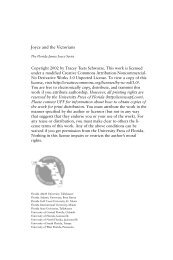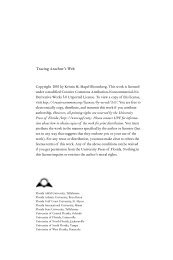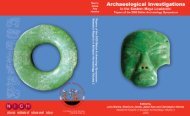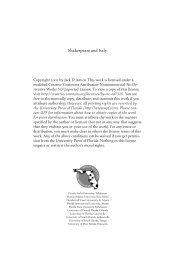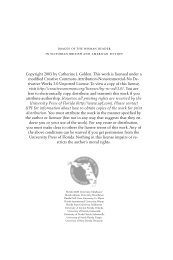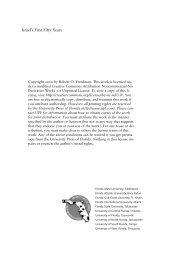Bernard Shaw's Remarkable Religion: A Faith That Fits the Facts
Bernard Shaw's Remarkable Religion: A Faith That Fits the Facts
Bernard Shaw's Remarkable Religion: A Faith That Fits the Facts
You also want an ePaper? Increase the reach of your titles
YUMPU automatically turns print PDFs into web optimized ePapers that Google loves.
222 <strong>Bernard</strong> Shaw’s <strong>Remarkable</strong> <strong>Religion</strong><br />
this unity; to diminish consciousness is to reduce <strong>the</strong>m. If one imagines a<br />
series of such reductions, it becomes clear how <strong>the</strong>y shrink awareness.<br />
Eliminate everything from consciousness except your visual field: all<br />
thoughts, physical sensations, all perceptions except <strong>the</strong> visual. You can<br />
merely see and cannot even think about what you are seeing. You are still<br />
conscious, but it is a reduced sort of consciousness. Reduce that consciousness<br />
even fur<strong>the</strong>r to only <strong>the</strong> couch in <strong>the</strong> center of <strong>the</strong> field of vision, and<br />
<strong>the</strong>n fur<strong>the</strong>r still, shrinking it finally to a single pixel of visual information.<br />
Consciousness, at that point, would seem to have disappeared entirely,<br />
for without something to contrast it with a single bit of information<br />
is meaningless.<br />
This “connectedness” of <strong>the</strong> contents of our conscious minds is not <strong>the</strong><br />
only unique aspect of our mental lives. There is <strong>the</strong> whole array of atomic<br />
mental elements psychologists sometimes call “qualia”: <strong>the</strong> various distinct<br />
sensation of consciousness, like <strong>the</strong> color blue and <strong>the</strong> sound of a<br />
single note of a flute. We know <strong>the</strong>se things are attributes of our minds,<br />
not of <strong>the</strong> physical world, which has been deprived by modern science of<br />
all but ma<strong>the</strong>matical characteristics. But <strong>the</strong>re is no reason why <strong>the</strong> atomic<br />
(that is, irreducible) elements of <strong>the</strong> physical world might not have a oneto-one<br />
correspondence with <strong>the</strong> atomic elements of <strong>the</strong> mind. <strong>That</strong> is an<br />
unfamiliar concept, but it is not unreasonable—unless, that is, you assume<br />
that <strong>the</strong> material world can have no qualities that are invisible to us.<br />
Something like that would have to be true if <strong>the</strong> materialist view of<br />
mind is even partly correct. On <strong>the</strong> materialist view, in a perfect neurological<br />
science a living brain could be examined (using some technology presently<br />
unimaginable), and scientists could say with perfect confidence,<br />
“This patient is thinking about a green two-story house.” Not only that,<br />
<strong>the</strong> scientists would have to be able to identify <strong>the</strong> source of all of <strong>the</strong><br />
various elements of that patient’s conscious experience: each “pixel” (as it<br />
were) of information in <strong>the</strong> subject’s mind. Yet even if <strong>the</strong>y could achieve<br />
such an amazing feat, <strong>the</strong>y would not be able to understand <strong>the</strong> peculiar<br />
structure of consciousness because it is a structure alien to <strong>the</strong> conceptual<br />
world of materialist science. The structures of <strong>the</strong> physical world—like <strong>the</strong><br />
crystalline lattice of molecules in a solid—are all defined in time and space.<br />
The relationship of each molecule to <strong>the</strong> o<strong>the</strong>rs, or of <strong>the</strong> atoms within <strong>the</strong><br />
molecules, is strictly a matter of having a constant distance through time<br />
from <strong>the</strong> o<strong>the</strong>rs. The elements of awareness are related in an entirely different<br />
way, a way that is unique and thus cannot be described by comparison<br />
to anything. All we can say is that <strong>the</strong> molecules do not have—or at



